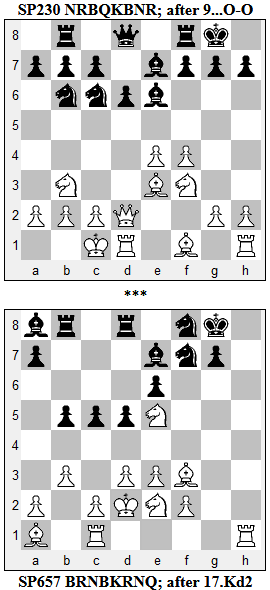- Strong opponents
- Insufficient engine power
- Too many games
- Fast time control
- Too many vacations
Although none of these factors is exclusive to chess960 -- they can apply equally to the traditional start position -- at the end of that post I mentioned another factor that is exclusively chess960:-
I had several pairs of games -- the same start position against the same opponent playing White in one game and Black in the other -- where I reached uncomfortable positions in both games after 10-15 moves. That means there is something wrong with my approach to chess960 openings.
A few years ago, in May/June 2015, I wrote a series of five posts where I looked at five painful losses:-
- On a Losing Streak
- Passive vs. Active Play
- An Imperfect Understanding
- Botched Castling
- Being Outplayed
The second post in that list ('Passive vs. Active') counted '[four] extenuating factors in the string of losses'. These match the first four above. Back in 2015, vacation didn't play a role, so at least I'm consistent with my excuses. Another characteristic of 'Losing Streak' was that 'in all five games I had Black'.
Looking at the more recent series of losses (+0-9=1, horrors!), I noticed two games with Black that I lost without a fight. The diagrams below show both games after the castling choices have been made. That is the point where the same techniques used to analyze traditional chess also apply to chess960.
In the top position, the players have castled to opposite sides. You can almost count the nine individual moves that have been made by both players to arrive at their respective positions. The game continued with a typical strategy for castling on opposite sides: both players launched a Pawn attack against the castled King. White eventually achieved an overwhelming attack while Black achieved nothing. After another 20 moves, Black resigned.

In the bottom position, White hasn't castled, but the King is in no particular danger. Black's King, however, is threatened by the Bishop on the long diagonal and the two Rooks on the open g- and h-files. These combined forces eventually won a Pawn, during which the Black Pawns on b5, c5, & d5 became increasingly vulnerable. The game lasted another 25 moves.
Since both games are essentially lost at the diagrammed position, an error must have been made before the diagram was reached. But where? In the third game of 'Losing Streak' above, analyzed in the post titled 'Imperfect Understanding', HarryO weighed in with a series of comments. The first comment was 'every move you played in the opening lacked initiative'. While that was undoubtedly an oversimplification, it still contained a big grain of truth. My approach to playing a chess960 opening with the Black pieces is:-
- Pay attention to the intermediate goals of piece development, of the fight for the center, of King safety, and of keeping a healthy Pawn structure;
- Avoid the quick, tactical knockout; and
- Give the move back to the opponent to see what comes next.
In the two games shown above, I failed with the goal of King safety. It took more than 20 moves to realize this for certain, but the seeds of defeat were already planted in the diagrammed positions. At what point should an early fight for the initiative play a role?
